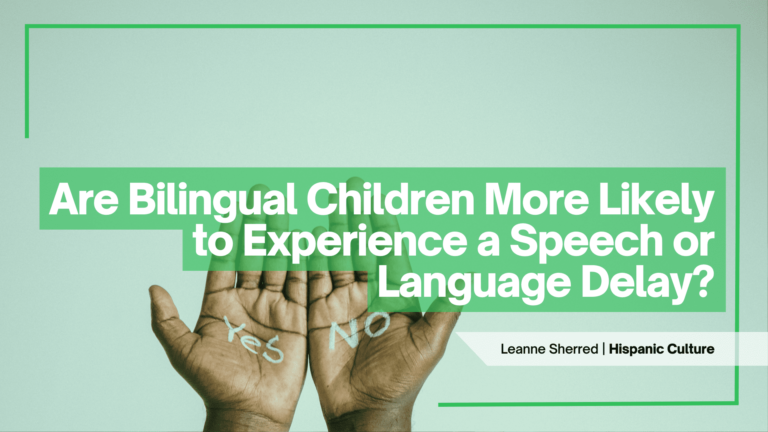Stop me if you’ve heard this myth before: raising your infant or toddler in a bilingual household, or teaching them two languages at once, could cause a speech or language delay.
This is a common and pervasive perception that continues to cause confusion and concern among not only parents of bilingual children but also teachers and pediatricians.
This question has taken on new prominence in recent years as more and more children grow up speaking multiple languages at home. In 1980, approximately 11% of households in the United States were bilingual, according to the annual American Community Survey (ACS). As recently as 2018, that number has nearly doubled to 21%, representing close to 63 million people.
In short, bilingualism does not cause speech or language delays. These beliefs are often based on misconceptions rather than scientific research and facts.
In this article, I’ll cover some o pressing questions about your child’s bilingual speech development, and provide tips and techniques to raise proficient and confident communicators within a bilingual household.
Let’s start with the basics.
Join more than 559 million people on the planet who speak Spanish!
Sign up for your free trial Spanish class today. 


What is a Speech and Language Delay?
Speech and language development often begins with slight cooing in infancy. It then progresses to babbling, and eventually a child produces their first understandable words.
While every child develops on their own timeline, speech-language pathologists look for general milestones when determining a child’s speech habits and proficiency. For example, a typical two-year-old should be able to intelligibly say about 50 words in two- and three-word sentences. From there, a child’s vocabulary rapidly increases, and by age 3 they should be using as many as 1,000 words in everyday conversation.
A child may be considered to have a speech delay if they don’t meet these typical milestones. This is a common problem that can affect up to 10% of preschool children, regardless of whether they’re learning to speak one or two languages.
Speech delays can often be confused with language delays. However, these are two separate conditions (although a child may have both). While speech delays affect a child’s articulation of words, a language delay can occur when a child has trouble using and understanding words.
For example, they may have difficulty learning new vocabulary words or stringing words together into coherent sentences (expressive language disorder). They may also find it challenging to extract meaning from the words they hear around them (receptive language disorder).
Yes, children learning two languages at once can experience speech or language delays. However, they are no more suseptible than monolingual children.

Where Does This Myth Come From?
It’s never easy to identify the genesis of a myth. However, this long-standing misbelief most likely springs from the idea that bilingual children are more prone to confusion. In other words, they don’t fully grasp how and when to use vocabulary because it’s split between two languages, which can lead to a “silent period.”
If we want to get technical, this is actually a common occurrence that’s called “code-mixing.” This means that a child (or an adult) may mix words from two languages into the same sentence. While this is a completely normal part of bilingual speech development, research has dispelled the myth that it causes a delay in their communication abilities.
A bilingual child may code mix for two reasons:
- All children learn language from listening to those around them—namely, their parents and caregivers. If you’re bilingual yourself, or live in a bilingual community, you know that adults code mix all the time. Children simply absorb and repeat what many of us do everyday.
- Compared to a monolingual child, a bilingual child may not have the same expansive bank of vocabulary words available in both languages to draw from. Therefore, they may “borrow” the word from another language. This isn’t a deficit at all! Quite the contrary, this demonstrates a child’s resourcefulness and ingenuity to form sentences using all available information.
As children get older and their linguistic abilities expand, they’ll be able to distinguish and modulate between the two languages their conversational partners use.
One helpful tip is to keep the language that’s being spoken to your child consistent in the moment. While it’s okay if your child code mixes on their own, you should try not to combine languages in the same setting.
For example, if you’re speaking Spanish at the breakfast table, speak Spanish. If you later use English at the playground, then use English. Also, encourage family members to speak the language that they’re most comfortable with.
What are the Benefits of Raising Bilingual Children?
Now that we’ve debunked the idea that bilingualism can cause speech or language delays, let’s turn this question on its head. Can raising a bilingual child actually increase their language development?
A mountain of research has sought to answer this question. Let’s look at some of the common advantages of teaching your child two languages at once.
Personal Abilities
Bilingualism opens people up to a world of possibilities and a slew of advantages when it comes to employment, speaking with extended family members, making friends, understanding and appreciating different cultures, and more. These reasons alone should encourage anyone to learn a new language.
Social Understanding
Social skills are a key part of childhood development. This refers to how children respond to different social situations, their ability to empathize and understand people with different perspectives and backgrounds, and how they communicate and act in group settings (for example, sharing toys, using appropriate facial expressions, actively listening, or managing their emotions).
Studies have shown that bilingual children have increased social awareness and understanding, which is not surprising. In many cases, bilingual children are navigating a more complex social environment, as well as interacting with people from different cultures.
Cognitive Advantages
While the cognitive advantages of knowing more than one language is well-documented in adults, research (here and here) also suggests that toddlers and infants display improved cognitive development.
More specifically, young children may show increased abilities to switch between activities and perform executive functioning tasks (such as time management, multitasking, problem solving, and working memory) that are critical for academic and professional success.
These advantages seem pretty obvious when you think about it: bilingual children are constantly practicing their ability to switch between languages, honing skills like selective attention and cognitive flexibility. These skills are essential to all aspects of our lives, even beyond language development.

Supporting Bilingual Language Development at Home
When it comes to bilingual speech and language development, parents and caregivers play a key role. Many at-home activities and routines help improve your child’s vocabulary development, speech proficiency, and comprehension of both languages.
However, all of these techniques come down to one simple principle: exposure. Expanding your child’s bilingual learning comes from constant and fully immersive exposure to both languages. Frequently speaking and interacting with your child in each language—and providing ample encouragement throughout the learning process—will help them grow and develop into a bilingual communicator.
It’s important to note that language development has countless positive downstream effects for children: it helps improve their literacy skills, reading comprehension, and academic success.
Nevertheless, patience is key! It may sometimes be discouraging for parents raising a bilingual child when you hear them mixing their languages. However, as mentioned previously, this is completely normal. What’s important is that you provide plenty of practice, persistence, and encouragement!
Language-building Activities to Practice with Your Child at Home
1. Narrate Your Daily Life
It sounds simple, but children grow their language skills from listening to those around them. One way to immerse them within a language-rich environment is to simply narrate the activities and daily routines you’re performing together in the target languages you’re teaching: mealtime, bath time, getting dressed, playing outside.
Just simply describe what you’re doing in the moment (like using soap to get clean, cooking dinner, or brushing your teeth) in either language. They’ll be incorporating these phrases into their language habits in no time!
If you don’t speak the target language you’d like your child to learn, be sure to sign them up for 1-on-1, professional Spanish classes with the wonderful teachers at Homeschool Spanish Academy!
2. Language Expansion
Natural language expansion is an effective technique that speech therapists use all the time. The concept is simple: put the words your child is saying into a longer phrase for them to imitate.
For example, if your child regularly says “jugo” to signal they’re thirsty, you can respond back by saying “jugo, por favor.” You always want to be working one skill level above your child. So, if they’re already saying two-word phrases such as “jugo, por favor,” you can model back a three-word phrase like “quiero más jugo” or “me gusta jugo.”
The simplest way to accomplish this is to connect your child with a native Spanish speaker, which we provide at Homeschool Spanish Academy. Learn more about how the program works!
3. Model Correct Language
When practicing your child’s communication skills, try to resist the temptation to “overcorrect” their speech errors. Constantly interrupting your child can lead them to feel frustrated and discouraged, and they may be less likely to practice.
What you can do instead is correctly model the word or phrase your child should have said at that moment. For example, if they’re using the word “ugo” instead of “jugo,” then just use the proper pronunciation when you hand them the beverage.
4. Read Regularly
A child’s ability to read fluently, identify items in pictures, and comprehend both written and verbal language is key to their development. Reading regularly is essential for a child’s budding brain, starting in infancy. Reading constantly to your child, and switching between both languages, improves their vocabulary, comprehension, and listening skills. Here is a list of free Spanish books to read to your children.

How to Tell if Your Child has a Speech Delay
While learning two languages doesn’t cause a speech delay, it can still happen to any child. It can be difficult to determine whether your child is just a late talker who will soon catch up or if there’s a more serious challenge that requires intervention.
If you have concerns that your child may have a speech or language delay, it’s generally recommended that you receive a full evaluation from a licensed speech-language pathologist. There are many bilingual speech therapists who can help evaluate, diagnose, and treat communication issues in children.
Common Signs of a Speech Delay
Here are some common signs that could signal a speech or language delay for kiddos between 18-30 months old:
Understanding Language
Language includes much more than verbal language. If your child can understand language and follow simple directions, they’re more likely to catch up with their peers. If they’re not able to comprehend or grasp what you’re saying, there could be a more severe issue at hand. After all, children must be able to comprehend language before they can use it themselves.
Using Gestures
Similarly, pay close attention to whether your child is actively using gestures to communicate (such as waving hello and goodbye, pointing to objects they desire, or raising their arms to signal they’d like to be picked up). This is a key component of language development and means your child is more likely just a late bloomer.
Learning New Words
At this age, children should be regularly learning and applying new vocabulary words to their speech. They should also be starting to put these words together to form short sentences, requests, and questions. If you don’t hear new words often, speak with your pediatrician, or seek help from a speech-language pathologist.
Move Forward with Speech Therapy
Speech therapy can be delivered in a variety of settings: a private clinic, school, or online. Increasingly, many parents and caregivers have turned to online speech therapy due to its effectiveness, affordability, and convenience. What’s most important is that you find a speech therapist and setting that works best for your child.
More Forward with Live, Kid-Friendly Spanish Instruction
Allowing your child to make a strong connection with a Spanish teacher online is a key to mastering their target language. Are you ready to encourage your little one to practice active listening and sharpen their Spanish speaking skills? Try a free class today with one of our native Spanish-speaking teachers from Guatemala. They’re equipped to meet your child at their level in a friendly and fun way that’s guaranteed to keep their interest!


Join one of the 40,000 classes that we teach each month and you can experience results like these

“This is the best way for your kid to learn Spanish. It’s one-on-one, taught by native Spanish speakers, and uses a curriculum.”
– Sharon K, Parent of 3

“It’s a great way to learn Spanish, from native Spanish speakers in a 1-on-1 environment. It’s been fairly easy to schedule classes around my daughter’s other classes. The best value for us has been ordering multiple classes at a time. All the instructors have been great!”
– Cindy D, Parent of 3

“HSA offers very affordable, quality, one on one classes with a native speaker. My son has greatly benefited from taking classes. We have seen his confidence increase as well as his pronunciation improve because he learns from a native Spanish speaker. HSA has quick, personal customer service. Our family has been very pleased with our experience so far!”
– Erica P. Parent of 1
Want some free Spanish lessons and fun content for kids? Check out our latest posts!
- 7 Powerful Reasons Why Bilingualism in Children MattersPowerful Reasons Why Bilingualism in Children Matters
- Fall En Español: Exploring Autumn Activities for Kids
- Fun and Language: Spanish Playdates for Kids
- Milestone Moments: Tracking Kids’ Spanish Progress
- Building Blocks: Kid-Friendly Spanish Grammar
- Top 5 Spanish Grammar Games to Improve Your Language Skills
- Tips for Introducing Your Toddler to the Spanish Language
- 10 Spring Activities to Keep Your Elementary Students Busy
The post Are Bilingual Children More Likely to Experience a Speech or Language Delay? appeared first on Homeschool Spanish Academy.



